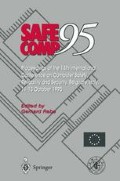Abstract
Although the issue of reliability is extensively discussed in the software engineering literature, it has received only limited attention in the Neural Computing community. In this paper, the software engineering concept of diversity is made use of to improve the performance of a neural net system solution to a problem of fault diagnosis in a marine diesel engine. Essentially the aim here was to find methods of creating a set of solutions which are diverse in the sense that they each fail on different inputs. A truly diverse set of solutions can be combined by means of a majority voter to yield 100% generalisation performance. The issue of identifying the best ways to promote diversity in neural nets was investigated in terms of a fault diagnosis problem in a marine engine. It was concluded that two effective methods for creating diverse solutions were (i) to take data from two different sensors, or (ii) to create new data sets by subjecting the set of inputs to non-linear transformations. These conclusions have far reaching implications for other Neural Net applications.
Access this chapter
Tax calculation will be finalised at checkout
Purchases are for personal use only
Preview
Unable to display preview. Download preview PDF.
References
Adams, J.M. and Taha, A. (1992) “An Experiment in Software Redundancy with Diverse Methodologies,” Proc of the Twenty-Fifth Hawaii International Conference on Systems Sciences.
Avizienis, A. & Kelly, J.P.J. (1984) Fault diagnosis by design diversity: Concepts and experiments. IEEE Comput. 17, 8, 67–80.
Banisoleiman, K., Smith, L.A., & Matheieson, N. (1993) Simulation of diesel engine performance, Trans of the Institute of Marine Engineers, 105 (3) 117–135.
Cottrell, G.W., Munro, P. & Zipser, D. (1989) “Image compression by back propagation: An example of extensional programming”, In (Ed.) Noel E. Sharkey, Models of Cognition: a review of Cognitive Science, Ablex, New Jersey, 208–241.
Dahll, G. and Lahti, J. (1980) “An investigation of methods for production and verification of highly reliable software”, In L. Lauber (ed) Safety of Computer Control Systems (Proc. SAFECOMP’79), New York: Pergamon.
Denker, J., Schwartz, D., Wittner, B., et al (1987) Large automatic learning, rule extraction and generalisation. Complex Systems 1, 877–822.
Gopinath, O.C. (1994) “A neural net solution for diesel engine fault diagnosis”, MSc thesis, University of Sheffield.
Knight, J.C. and Leveson, N.G. (1986) An experimental evaluation of independence in multiversion programming. Trans on Software Eng, Vol SE- 12 no 1.
Littlewood, B. and Miller, D.R. (1989) Conceptual modeling of coincident failures in multiversion software. IEEE Trans. on Software Engineering, 15, (12).
Martin, D.J. (1983) Dissimilar software in high integrity applications in flight controls,” In Software for Avionics (AGARD Conf. Proc. 330), Jan, 1983, pp36-1–36-9.
Partridge, D. & Sharkey, N.E. (1994) Neural computing for software reliability. Expert Systems, 11, 3, 167–175.
Ramamoorthy, C.V., Mok, Y.R., Bastani, E.B., Chin, G.H. and Suzuki, K. (1981) “Application of a methodology for the development and validation of reliable process control software” IEEE Trans. Software Eng., vol SE-7, pp 537–555.
Sharkey, A.J.C. and Sharkey, N.E. (in press) Cognitive Modelling: Psychology and Connectionism. In (Ed.) M.A. Arbib The Handbook of Brain Theory and Neural Networks, Bradford Books/MIT Press.
Sharkey, A.J.C., Sharkey, N.E. and Gopinath, O.C. Diversity, (1995) Neural Nets and Safety Critical Applications. In Proceedings of The Second Swedish National Conference on Connectionism. pp 165–178. Lawrence Erlbaum Associates, Hillsdale: New Jersey.
Sharkey, N.E., Neary, J. and Sharkey, A.J.C. (1995) Searching weight space for backpropagation solution types. In Proceedings of The Second Swedish National Conference on Connectionism. pp 103–120. Lawrence Erlbaum Associates, Hillsdale: New Jersey.
Sharkey, N.E. and Partridge, D.P. (1992) The statistical independence of network generalisation: an application in software engineering. In P.G. Lisboa & M.J. Taylor (Eds) Neural Networks: Techniques and Applications Chichester, UK: Ellis Horwood.
Sharkey, N.E. and Sharkey, A.J.C. (1993) Adaptive Generalisation. Artificial Intelligence Review, 7, 313–328.
Taylor, J.R. (1981) “Letters from the editor”, ACM Software Eng Notes, vol 6, no 1, pp 1–2.
Author information
Authors and Affiliations
Editor information
Editors and Affiliations
Rights and permissions
Copyright information
© 1995 Springer-Verlag London
About this paper
Cite this paper
Sharkey, A.J.C., Sharkey, N.E., Chandroth, G.O. (1995). Neural Nets and Diversity. In: Rabe, G. (eds) Safe Comp 95. Springer, London. https://doi.org/10.1007/978-1-4471-3054-3_25
Download citation
DOI: https://doi.org/10.1007/978-1-4471-3054-3_25
Publisher Name: Springer, London
Print ISBN: 978-3-540-19962-5
Online ISBN: 978-1-4471-3054-3
eBook Packages: Springer Book Archive

